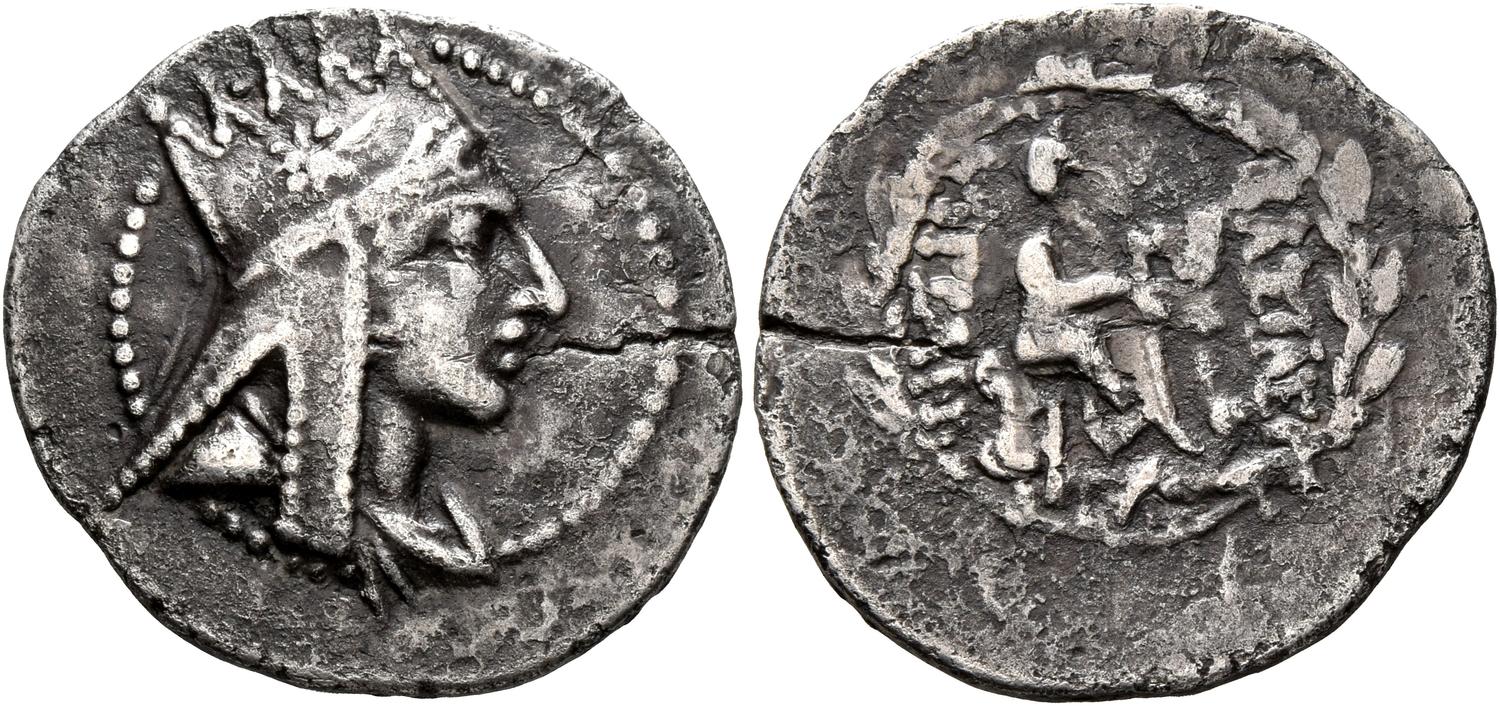Tigranocerta (Tigranes II), silver, drachms (68-65 BCE)
From SILVER
68 BCE - 65 BCE Silver 223 kg
Description
| ObverseInscription or printing placed on the obverse.: | Draped bust of Tigranes the Younger to right, wearing five-pointed Armenian tiara decorated with a comet and tied with a diadem |
| ReverseInscription or printing placed on the reverse.: | ΒΑΣΙΛΕΩΣ TIΓΡΑΝΟΥ (Greek).The Tyche of Artagigarta (?) seated to right on rock, holding long palm frond in her right hand, below, river-god Tigris swimming right. |
Mint and issuing power
| MintIdentifies the place of manufacture or issue of a numismatic object.: | Tigranocerta | Ancient regionAncient region.: | Armenia | Modern countryModern country: Turkey | AuthorityIdentifies the issuing power. The authority can be "pretended" when the name or the portrait of X is on the coin but he/she was not the issuing power. It can also be "uncertain" when there is no mention of X on the coin but he/she was the issuing power according to the historical sources: | Armenian kingdom, Tigranes II of Armenia (Artaxiad king, c. 95-56 BC) |
Chronology
| FromIdentifies the initial date in a range assigned in a numismatic context. | 68 BCE | toIdentifies the final date in a range assigned in a numismatic context.. | 65 BCE | PeriodTime period of the numismatic object.: Hellenistic 323-30 BC |
Physical description
| MetalThe physical material (usually metal) from which an object is made.: | Silver |
Median weightMedian of the weights of numismatic objects (in grams). in grams | 4.00 | DenominationTerm indicating the value of a numismatic object. Examples: tetradrachm, chalkous, denarius.: | drachma |
StandardStandard.: | Attic |
Image

S95 Tigranocerta Tigranes II drachms.jpg [1]
References
| Die study referencePublication of the study: | Nercessian 20061Nercessian 2006, p. 84 | ||
| Coin series referenceReference to coin series study: | Kovacs 20162Kovacs 2016, n° 154 | ||
Obverse dies distribution
| FrequencyFrequency of specimen in distribution. ᵖ | Number of obversesNumber of obverse dies. ᵖ (o) | % (o) | Number of coinsNumber of coins. (n) | % (n) | Die nameName(s) of the die(s). |
| 1 | 1 | 50 | 1 | 20 | 2 |
| 4 | 1 | 50 | 4 | 80 | 1 |
| Total | 2 of 2 | 100 | 5 of 5 | 100 |
Reverse dies distribution
no distribution is available
Quantification
| Number of obversesNumber of obverse dies. ᵖ (o) | 2 | Number of singletons (o1)The number of singleton coins. ᵖ | 1 |
| Number of reverse diesNumber of reverse dies. (r) | 2 | Number of coinsNumber of coins. (n) | 5 |
| Coins per obverse dieNumber of coins per obverse die. (n/o) | 2.5 | Coins per reverse dieNumber of coins per reverse die. (n/r) | 2.5 |
| Reverse per obverse ratioRatio of obverse dies divided by reverse dies. (r/o) | 1 | Percentage of singletons (o1)number of coins (n) divided by the number of singletons (o1) ᵖ | 50 % |
| Original number of dies (O) (Carter 1983 formula)The estimation of the number of coins according to Carter 1983 ᵖ | 2.79 | Coins struck if 20,000 as average productivity per dieCoins made if the average productivity for obverses (according to Carter) is 20,000. ᵖ | 55,800 |
| Original number of dies (O) (Esty 2011 formula)The estimation of the number of coins according to the singleton formula in Esty 2011 ᵖ (O) | 3.33 | Survival rate if 20,000 as average productivity per dieSurvival rate if average productivity is 20,000. ᵖ | 0.00009 |
| Coverage (o = % of O) (Esty 1984 formula)Esty 1984 - coverage (% of O) ᵖ (o = % of O) | 80% | Die productivity if survival rate 1/2,000Average productivity if survival rate is 1/2,000. ᵖ | 3,584.23 |
| Weight of silver (in kg) if 20,000 coins per die (O = Carter formula)Carter 1983 * Median weight * 20000 (*10 if gold or electrum) ᵖ | 223 kg <br /> 223 kg | Die productivity if survival rate 1/5,000Average productivity if survival rate is 1/5,000. ᵖ | 8,960.57 |
Remarks
Most likely one single workstation Likely military